






Night falls on the Battlefield---
Longstreet's March ---
Sickles' Advance ---
Temporary Insanity ---
Fighting at Devil's Den, the Wheatfield and the Peach Orchard ---
In Defence of Little Round Top ---
Two Future Governors Battle ---
The First Minnesota ---
Action on Culp's Hill ---
Early Advances Against Cemetery Hill ---
The Situation on the Evening of July 2nd
Night Falls on the Battlefield
A full moon shone across the now-bloodied fields of Gettysburg. Both sides sought to bring up reinforcements and strengthen their lines. Union troops, thankful not to have been destroyed during the first day of the battle, found little rest with the coming of nightfall. Throughout the night, they worked to build fortifications on both Cemetery and Culp's Hills.
Before 6:00 a.m. on the second day, Lee, Hill, Heth, Hood and Longstreet met on Seminary Ridge for an informal council of war. Lee outlined his plan to hit the Union lines in a classic pincer movement, turning Meade's flanks and rolling up the Union army. Longstreet's First Corps would attack the south end of the line, while Ewell's Second Corps would storm across Culp's Hill and the northern-most part of Cemetery Hill. Hill's Third Corps would strike at the Union center. Longstreet argued against continuing to fight at Gettysburg, believing it to be better to swing around the Union lines and get between Meade and Washington, and await an attack. Lee dismissed the idea, stating that he would win or lose here. Lee still had no word from Stuart, so he was unsure of the enemy's actual strength or whether Meade had forces in reserve.
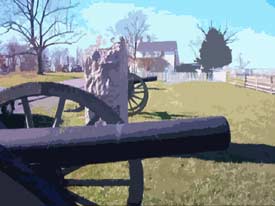
General Meade had arrived on the battlefield during the evening of July 1st and established his headquarters in a small farmhouse at the northern edge of Cemetery Ridge. Drawn into battle by the actions of his subordinates, Meade had expected to arrive in Gettysburg to find his forces defeated. Indeed, the Union forces engaged during the first day of battle had suffered 28 percent casualties, including nearly 3500 captured or missing as opposed to the 22 percent suffered by the Confederates. In the Union's favor, most of the Army of the Potomac had arrived on the battlefield by the time fighting resumed on July 2nd.
Meade arranged his troops into what would be called "the fish hook". XII Corps manned the wooded Culp's Hill, which measured 140 feet in height and would serve as both the point of the hook and the anchor of the line's right flank. A half-mile to the northwest was Cemetery Hill, which was occupied I Corps and XIth Corps, reinforced by artillery. II Corps and III Corps were stationed along Cemetery Ridge, which stretched two miles from Cemetery Hill to Little Round Top. III Corps' position was anchored by Little Round Top, which loomed 305 feet above the valley below and served as the "eye of the hook". In all, the Union line stretched between three and a half to four miles in length. V Corps was held in reserve, until Meade knew better of Lee's intentions. It wasn't until late afternoon when Longstreet finally got his men into position. Hood's division was at the southern most part of the Confederate lines, with McLaw's troops extending his lines to the north. Colonel E. Porter Alexander's Confederate artillery was already in position, as they had been for the last three hours, after Alexander found a concealed shortcut the infantry had missed. Over 50 guns were massed along the southern end of the Confederate line in hopes of softening up the Union lines. Daniel Sickles, commanding the 12 000 men of III Corps, had objected to the positioning of his troops. Meade and Sickles had clashed several times during the past few days, with Meade stating at one point that Sickles' Corps was not keeping pace with the rest of the army in their march towards Gettysburg. Now, Sickles felt that the ground on which his troops had been positioned was too low to be easily defended. Meade had ordered Sickles to connect his lines with the left of II Corps, but would later allow Sickles to use his best judgment in the positioning of his troops. Sickles would take advantage of that change in orders, using reports of incoming Confederate infantry as incentive to move forward. Sickles certainly went beyond the letter of the orders given, ordering his Corps forward a distance of anywhere from half to three-quarters of a mile and maneuvered them into an arrowhead-like formation. In the very center of Sickle's new position was a small peach orchard owned by J. Sherfy, with his left stretching across a wheatfield to a rocky eminence some 500 yards southwest of Little Round Top, dubbed Devil's Den by Gettysburg citizens. His right flank stretched along Emmitsburg Road towards Gettysburg, but did not connect with the lines of II Corps and left both the Union left flank and the Round Tops undefended. By the time Meade had realized what was happening and angrily called for Sickles to pull back, Longstreet was beginning his attack and the artillery of both sides were engaged.
During the battle, Sickles was badly wounded, losing a leg to enemy cannon fire. Sickles called for a soldier to apply a saddle strap as a tourniquet, then turned command of III Corps over to Major General David Birney, one of his division commanders. It was only then that he allowed himself to be taken from the field.
Longstreet's March
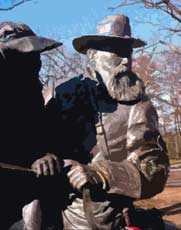 McLaws and Hood, leading the divisions of Longstreet's Corps, were in position to begin their attack by midday, but as they began their march against the Union lines, they realized that they were under the watchful eyes of Federal signalmen on Little Round Top. The two Confederate divisions fell back almost to the starting point of the march and then, with Hood now in the lead, turned south along Willoughby Run before turning east. In order to conceal themselves from Federal scouts, Longstreet's men would march nearly eight miles before being able to form up in attack position.
McLaws and Hood, leading the divisions of Longstreet's Corps, were in position to begin their attack by midday, but as they began their march against the Union lines, they realized that they were under the watchful eyes of Federal signalmen on Little Round Top. The two Confederate divisions fell back almost to the starting point of the march and then, with Hood now in the lead, turned south along Willoughby Run before turning east. In order to conceal themselves from Federal scouts, Longstreet's men would march nearly eight miles before being able to form up in attack position.
Sickles was no stranger to controversy. Two years before the outbreak of the war, Sickles had become convinced that his wife was having an affair. Enraged, he challenged his wife's lover, Philip Barton Key (the son of Francis Scott Key, the author of "the Star Spangled Banner), to a duel in Lafayette Park, just across Pennsylvania Avenue from the White House.
Sickles won the duel, killing Key. Sickles was summarily tried for murder but his lawyer, future Secretary of War, Edwin M. Stanton, entered a plea of temporary insanity, the first time in legal history that such an action had been taken. It worked, as Sickles was acquitted of the murder charge. Later, he entertained further scandal by taking his wife back.
After being wounded at Gettysburg, he ordered his shattered leg to be preserved in army issue whiskey. Sickles would take to carrying the leg around with him in a case, in case anyone wished to view it. Later, he donated it to a medical museum, where he visited it every year.
Fighting at Devil's Den, the Wheatfield and the Peach Orchard
The Confederate attack, so long in coming, was barely underway before problems began. First of all, Hood's division began its assault a full hour and a half before McClaws' division. As well, the Confederates had difficulty negotiating the rocky terrain before the Round Tops. Shortly after the attack began, John Bell Hood (left) was struck by a shell fragment and severely wounded, forcing him to leave the field. Evander Law was named as his temporary replacement.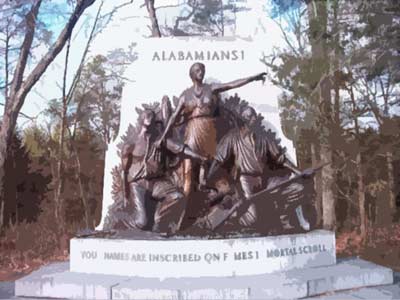
At the lower slope of Big Round Top, Law and Brigadier General Jerome Robertson's troops ran into Union artillery and musket fire. So heavy was the fighting during the next hour and a half, the area was nicknamed "the Devil's Kitchen" by the men who fought there. Confederates from Texas, Arkansas and Alabama battled Federals from Maine and New York in bitter fighting that produced heavy casualties on both sides.
In the area between Little Round Top and Devil's Den, men of the 44th Alabama charged the positions of the 4th Maine. The battle raged for just twenty minutes, costing the Alabamians a quarter of their number. They managed to drive the Maine men back to beyond Devil's Den, but the area would receive the nickname of "the Slaughter Pen".
Devil's Den itself was a collection of rocks and boulders. The Union put the 4th New York Battery (commanded by James E. Smith) and Hobart Ward's brigade there in defense. These men came under attack by the 1st Texas and 15th Georgia regiments. The Confederates nearly overwhelmed the Union defenders before Major James Cromwell led his 124th New York into battle. Cromwell was killed soon after the counter-attack began and his replacement, Colonel Augustus Van Horne Ellis was killed not long after. The Confederates managed to capture three Union guns and drive the defenders out of Devil's Den.
In the Wheatfield, which lay to the northwest of Devil's Den, the five Georgia regiments (led by Brigadier General George Anderson) which comprised Hood's 4th Brigade battled the troops under David Birney, whose left flank had been crushed by other Georgian troops in what became known as "the Valley of Death", the gorge through which the Plum Run flowed. The 4th Brigade pushed Birney's remaining troops back through the Wheatfield, only to be stopped by two brigades of V Corps. In all the Wheatfield would change hands six times over the course of the battle.
As Anderson and the men of 4th Brigade retired from the Wheatfield, the brigades of Brigadier Generals Joseph Kershaw and Paul Semmes of McClaws' division took their places. Finally, the second wave of Longstreet's attack had begun. Kershaw's Georgia brigade led the way, with Semmes' Georgians behind them. They were soon under fire from Union artillery, which punched bloody holes in their lines, but the newly arrived Confederate troops still managed to push the Federals back. Kershaw's brigade, then fought its way through the Peach Orchard on the receiving end of even more Union artillery fire.
By that point, Meade had ordered the 3300 men of Brigadier General John Caldwell's division (from II Corps) into battle along the front now under attack from Kershaw, Semmes and Anderson. The fighting went back and forth, with one Federal regiment being hit hard, while the other three managed to drive the Confederates back. The Rebels then counterattacked and drove the Federals from the Wheatfield, but got no further as the Union troops managed to stop the Confederates.
Meanwhile, events in the Peach Orchard were unfolding that would eventually send the Union troops in the Wheatfield scrambling for safety. At about 6:00, McClaws' final two brigades began their attack against the Union left. General William Barksdale led a brigade of Mississippians in what one Confederate called "the most magnificent charge I witnessed." Screaming a savage yell, Barksdale's men collided with the 57th and 114th Pennsylvania and destroyed the two Federal units. Within minutes of meeting up with the 21st Mississippi, the 141st Pennsylvania lost 156 of 209 men. The 68th Pennsylvania was quickly routed and the 105th Pennsylvania lost half its strength. Soon, the Mississippians were across the Emmitsburg Road and, with the help of William Wofford's Alabama brigade, were crushing Sickles' lines.
The 21st Mississippi and Wofford's Alabama brigade wheeled right and met up with Anderson's, Kershaw's and Semmes' troops to sweep across the Peach Orchard and the Wheatfield. The Union troops fled in terror before them, with many brigades having to fight to avoid becoming trapped amid the converging Confederate lines.
As the victorious Confederates raced after the fleeing Yankees, they ran into the Pennsylvania reserves of Brigadier General Samuel Crawford's division. As the Confederates approached, Crawford grabbed a flag and the reserves charged down the hillside. They fired two volleys and then charged into the Confederate lines. Surprised by this resistance, the Confederates retreated back to the eastern edge of the Wheatfield, where they found adequate cover behind a stone wall there.
In Defence of Little Round Top
Shortly after Longstreet's attack began, Colonel William C. Oates, commander of the 15th Alabama Oates' troops brushed aside a small contingent of U.S. sharpshooters and quickly occupied Big Round Top. As his men rested after their long climb, Oates received a message from Laws, who, with Hood down, was in command of the division. His orders were for Oates to move against Little Round Top and turn the Union's left flank.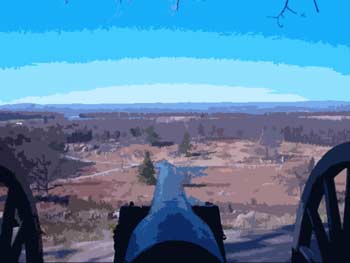
Oates, Laws and the rest of the Confederate commanders expected Little Round Top to be either undefended or lightly defended by Union troops. They knew that if they could get guns up on that rocky summit, some 300 feet above the bulk of the fighting, they could rain a destructive fire down on the Union lines, and roll up their flanks.
Thankfully for the Union, a small party led by General Gouverneur K. Warren, had scouted the hill just as Longstreet's action began. Finding only a few members of the Union's Signal Corps there, Warren and his staff quickly realized the danger of the situation. With Sickles pinned down in the Peach Orchard and Longstreet and Hood's men heading their way, the men knew that Little Round Top was in danger of falling into the hands of the Confederates.
Warren saw to it that Colonel Strong Vincent's brigade (of General George Sykes' V Corps) was quickly sent to occupy Little Round Top. Vincent's brigade included the 83rd Pennsylvania, 44th New York and the 16th Michigan. The final regiment, the 20th Maine, was led by a schoolteacher by the name of Joshua Lawrence Chamberlain. Representing the extreme left of the entire Union line, Chamberlain was ordered to hold Little Round Top "at all hazards".
Like all of Vincent's brigade, Chamberlain's men, numbering perhaps 350, were in position for less than 10 minutes when Oates' Alabamians attacked. For the next hour-and-a-half, the battle raged as the two forces fired in excess of 40 000 rounds. Oates ordered his men to charge again and again, but was unable to dislodge the 20th Maine. Oates' lengthened his line, and soon his men began to overlap the Union positions. Chamberlain "refused" the line, bending his line back so that it formed an "L" shape, and keeping his troops from being outflanked.
Fighting continued, with small groups of Rebels breaking the Union line, only to be thrown back in vicious hand-to-hand fighting. With ammunition running low, Chamberlain ordered his men to advance with bayonets fixed. While the right flank held firm, the left advanced, wheeling to the right, "like some great gate on a post", one eyewitness called it. As the Confederates retreated down the hill, a lone Maine company sent out to guard the flank but thought to have been overrun, suddenly reappeared. The Confederates broke and ran in the face of Chamberlain's advance. Chamberlain's 20th Maine had held Little Round Top, but with a dreadful price. Of the 386 men under Chamberlain's command, 130 were killed, wounded or captured.
Two Future Governors battle
Joshua Chamberlain would be awarded the Congressional Medal of Honor for his part in the defence of Little Round Top. He would later be elected Governor of Maine by the largest majority in the history of the state. The man who opposed him on July 2nd, 1863, William C. Oates, would be elected the governor of Alabama in 1894 after what one historian called "the most memorable campaign in the State's history."
Colonel Vincent was killed in the opening moments of the fighting that raged along Little Round Top. As he lay dying, he implored his men, "Don't give an inch." The men of Maine and Pennsylvania battled to drive back the men of Alabama and Texas who charged their lines.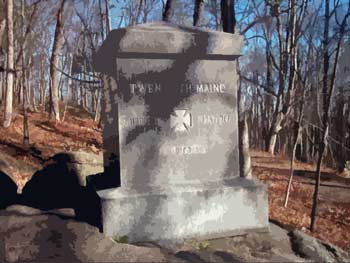
Even with the support of an Union artillery battery on the crest of Little Round Top, eventually the Federal lines began to crumble, only to be strengthened again by the arrival of Brigadier General Stephen Weed's brigade. The reinforcements charged into battle and were able to stop the onslaught of the 47th and 4th Alabama, which were threatening to overrun the Union positions.
Weeds and no fewer than three other Union officers were killed during the battle, and the Confederates fared no better. In the regiments that opposed the Federal defenders, all but one of the field officers were killed or wounded.
As the fighting raged on the Union's left flank, Richard Anderson sent three Confederate brigades, nearly 2500 troops from Alabama and Florida forward toward the center of the Union lines on Cemetery Ridge. Opposing them were the six regiments, 1700 men strong, of Joseph Carr's brigade. The Confederates marched through a heavy rain of canister fire from two Federal batteries and, coupled with Barksdale's assault through the Peach Orchard, Carr's men found themselves involved in bitter fighting on two fronts. With the added power of 1400 Georgian troops under General Ambrose Wright, Carr's troops were quickly driven back. Colonel William Brewster's New York Excelsior Brigade was sent forward in the hopes of stemming the tide of advancing Confederates. The New Yorkers, however, were quickly overrun and driven back with heavy losses. Birney, now in command in Sickle's absence, sent in several more regiments, but they did little more than put up token resistance to the onslaught of Rebel forces.
The First Minnesota
As Federal units raced towards the Wheatfield, an Alabama brigade discovered a gap in the Union lines upon Cemetery Ridge. As the Confederates marched to exploit it, Winfield Scott Hancock noticed their approach. Desperate, Hancock sent a small brigade, the 1st Minnesota (commanded by Colonel William Colvill) into the gap in order to stop the 1,600 Confederates that sought to break the Union line.
Bayonets fixed, the 1st Minnesota raced down the southwestern slope of Cemetery Ridge and charged into the Rebel line. Fighting gallantly, they paid a high price in order to temporarily halt the Confederate advance. Only 47 Union soldiers remained unharmed after ten minutes of fierce fighting. Their 82 percent casualty rate represented the highest that any Union regiment suffered over the course of the war.

The bravery and sacrifice of the 1st Minnesota had bought the Union precious time. Hancock was able to bring up George Willard's brigade and regrouped other units to throw against the enemy. They were enough to finally stop the Confederate assault and drive them off. Barksdale fell wounded in the chest, dying in Union hands the next day. Meanwhile, Alexander Webb's brigade stopped Wright's brigade and drove them back across the Emmitsburg Road before retiring back to Cemetery Ridge. By 7:30, the fighting along Cemetery Ridge had ended.
The fighting had been heavy along the southern end of the battlefield. 15 000 men had fallen, accounting for approximately 35 percent of both sides. Thirteen Union brigades had been demolished by the Confederate advance. In addition to Barksdale, the Confederates also lost William Pender, who suffered a mortal wound that cost him his life seventeen days later.
Action on Culp's Hill
The fighting on the northern end of the battlefield had commenced with an artillery bombardment of Culp's Hill and Cemetery Hill. Major J.W. Latimer commanded thirty-two Confederate cannon in an intense pounding of the Union lines that last two hours. The Union guns responded, and the duel, which lasted until 6:30, saw Latimer fall mortally wounded.
As the artillery fire subsided , Ewell ordered Edward Johnson's division forward. Hounded by Federal cavalry, Johnson was forced to send a brigade off to his left to cover his flanks. As well, the march took longer than expected (his troops had to cross Rock Creek) and Johnson's division didn't reach the base of Culp's Hill until twilight neared. Johnson's men continued forward, however, only to find navigating the terrain difficult, especially under fire from the Union guns of Brigadier General George Greene's brigade (of XII Corps) and James Wadsworth's I Corps division. Meade had all but stripped the Culp's Hills defenses in order to send aid to the Union left and center. Johnson's Confederates outnumbered the Federals who would oppose them.
Still, the troops manning the defenses on Culp's Hill were veterans and well-protected. The sixty-two-year-old Greene, known as "Pops" among his troops, kept up the fire against the advancing Confederates by bringing in reserves as the front-line troops exhausted their ammunition. With six regiments coming up from Wadsworth and Oliver Howard, Greene was able to keep the Confederates from gaining much ground.
On the left, a Confederate brigade under George Steuart managed to occupy a stretch of trenches abandoned by the Federals, the lone Confederate success on Culp's Hill that night. For the most part, however, the rough terrain, stiff opposition by Greene's troops and the coming of darkness quickly brought an end to the Confederate advance. As well, darkness prevented Johnson from realizing that Greene's troops were the only Union forces in the area, and that he was within striking distance of both the Union rear and the enemy's supply lines.
Early advances against Cemetery Hill

As the day's fighting began to come to a close, Jubal Early sent two brigades against the Union positions on Cemetery Hill. 2500 men in two brigades under Harry Hayes and Isaac Avery began their assault shortly after 7:30 p.m. It took them nearly an hour to cross the 700 yards of rough terrain that lay between their starting point in the fields of the William Culp farm to the base of Cemetery Hill.
There they faced opposition from two Union brigades, led by Colonel Leopold Von Gilsa and Colonel Andrew Harris, who were deployed behind a stone wall and were supported by four Union batteries. As the Confederates approached, they came under artillery fire and Avery was fatally wounded.
Closing in on the Union lines behind the stone wall, Avery's North Carolinians executed a right oblique, exposing themselves to artillery and rifle fire. The Confederates marched on, dispatching the Union defenders with relative ease. As well, the Confederates began to realize that the guns on Cemetery Hill could not lower their barrels to take aim at them as they scaled the hill. As the Union soldiers fled, the Rebels rushed ahead, attempting to overrun several Union artillery batteries.
With Avery's Confederates in danger of breaching their lines, Union commanders sent in reinforcements in an effort to drive off the enemy. The problem was that as regiments were sent to plug holes created by Avery's breach, holes were left elsewhere that Hayes' men could exploit. Hayes and his men soon began to pour through the Union lines.
In the darkness, Hayes found his men being fired upon. Unsure as to who these units were, Hayes was reluctant to order his men to return fire. Finally, too late, he realized that the volleys came from Union reinforcements. These were the men of Samuel Sprigg Carroll's brigade, who had marched all night to the battle. Under fire and in danger of being surrounded, Hayes' men were forced to retreat.
The Situation on the Evening of July 2nd
By the time the fighting ended on that second bloody day at Gettysburg, the long-absent J.E.B. Stuart had finally arrived. Many in the Confederate command and on Lee's staff were outraged at Stuart's "useless showy parade" as Lieutenant Colonel Gilbert Moxley, Longstreet's chief of staff dubbed it. Major Charles Marshall, Lee's chief of staff, called for Stuart's court martial, and later suggested he be shot. Lee simply greeted Stuart by saying "Well,General Stuart, you are here at last.", as much of a reprimand as Lee would give.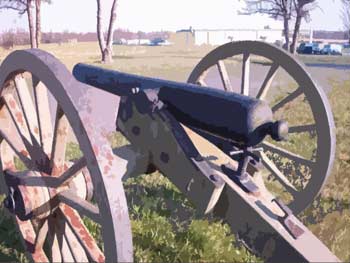
Lee's plans for July 3rd, as they stood upon his retiring for the evening, called for a renewal of the offensives on both flanks of the Union line. Lee told Longstreet to have Pickett bring up his division and use it in the attacks in the morning. He told Stuart to place four brigades beyond Ewell's left flank, with the intent of either attacking the Federal rear or retreating columns, should the attacks succeed.
Unlike Lee, who issued his orders without meeting with his generals, Meade held a council of war at his headquarters with all of his corps commanders (or their replacements) present. John Sedgwick, commander of the newly arrived VI Corps was present, as his corps had marched thirty-four miles in less than twenty-four hours, giving Meade a sizable reserve with which to work with.
The council began at approximately 9:00 and did not break up until midnight neared. Meade did little talking, allowing his men to discuss the condition of their troops, supplies, and their field positioning. Finally, at Daniel Butterfield's (Meade's chief of staff) urging, the corps commanders voted that the Army of the Potomac should stay in Gettysburg, adapt a defensive strategy and wait for the Confederacy to make their next move. Meade accepted that decision and the meeting broke up.
Much like the first day at Gettysburg, an argument could be made that the Confederates had missed their chance to gain a victory. E. Porter Alexander later stated, "it must be said that the management of the battle on the Confederate side during the afternoon was conspicuously bad. The fighting was superb. But there appears to have been little supervision."
After drafting the outline of the day's attacks, Lee had allowed his subordinates: Longstreet, Hill and Ewell, to carry out his orders as they saw fit. Sadly, gone were the days when Lee could count on "Stonewall" Jackson to ensure that his plans were implemented correctly. Misunderstood orders, mix-ups and a lack of aggressiveness from the Confederate corps commanders on down led to missed opportunities on all fronts. At no time were Hood, McLaws or Anderson able to lead a co-ordinated attack with all their units charging simultaneously. Two of Anderson's brigade never advanced. William Pender's brigade was set to support an assault by Ewell when Pender was hit. His replacement, James Lane, did nothing. Over on Culp's Hill, Rodes' command was to have come up in support of Hayes and Avery, but by the time he got his troops ready, the Confederate attack had been repulsed.
Despite an advance by Sickles that could have lead to the disintegration of the Union lines, hard-fighting by the Army of the Potomac had ensured that the Confederate plans for victory had been thwarted. Culp's Hill would remain in jeopardy until the early hours of July 3rd, but the rest of their lines on Cemetery Ridge, Little Round Top and Cemetery Hill remained intact.